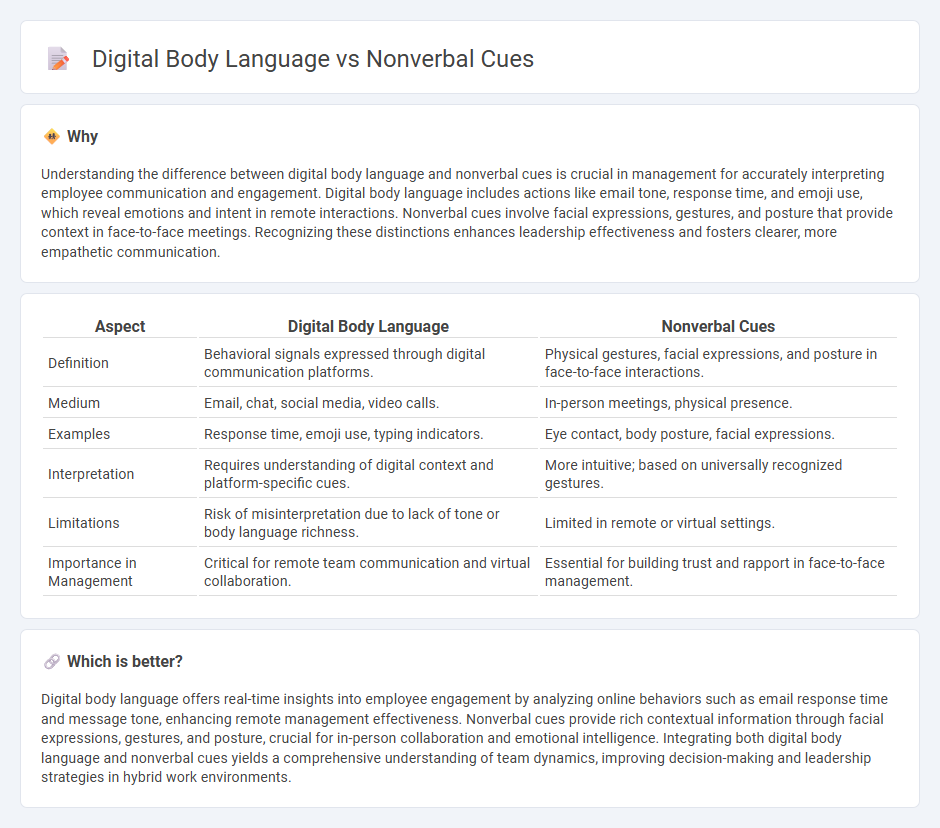
Digital body language encompasses the subtle online behaviors and signals individuals exhibit through emails, chats, and virtual meetings that convey emotions and intentions. Nonverbal cues involve physical gestures, facial expressions, and posture observed in face-to-face interactions to interpret feelings and attitudes. Explore how understanding both digital body language and nonverbal cues enhances effective communication and leadership in modern management.
Why it is important
Understanding the difference between digital body language and nonverbal cues is crucial in management for accurately interpreting employee communication and engagement. Digital body language includes actions like email tone, response time, and emoji use, which reveal emotions and intent in remote interactions. Nonverbal cues involve facial expressions, gestures, and posture that provide context in face-to-face meetings. Recognizing these distinctions enhances leadership effectiveness and fosters clearer, more empathetic communication.
Comparison Table
| Aspect | Digital Body Language | Nonverbal Cues |
|---|---|---|
| Definition | Behavioral signals expressed through digital communication platforms. | Physical gestures, facial expressions, and posture in face-to-face interactions. |
| Medium | Email, chat, social media, video calls. | In-person meetings, physical presence. |
| Examples | Response time, emoji use, typing indicators. | Eye contact, body posture, facial expressions. |
| Interpretation | Requires understanding of digital context and platform-specific cues. | More intuitive; based on universally recognized gestures. |
| Limitations | Risk of misinterpretation due to lack of tone or body language richness. | Limited in remote or virtual settings. |
| Importance in Management | Critical for remote team communication and virtual collaboration. | Essential for building trust and rapport in face-to-face management. |
Which is better?
Digital body language offers real-time insights into employee engagement by analyzing online behaviors such as email response time and message tone, enhancing remote management effectiveness. Nonverbal cues provide rich contextual information through facial expressions, gestures, and posture, crucial for in-person collaboration and emotional intelligence. Integrating both digital body language and nonverbal cues yields a comprehensive understanding of team dynamics, improving decision-making and leadership strategies in hybrid work environments.
Connection
Digital body language and nonverbal cues are integral to effective management, as they convey emotions and intentions beyond written communication. Understanding digital signals such as response time, emoji use, and message tone enhances a manager's ability to gauge team sentiment and engagement. Leveraging these cues improves virtual collaboration, decision-making, and leadership effectiveness in remote and hybrid work environments.
Key Terms
Proxemics
Proxemics, a key aspect of nonverbal cues, studies the use of physical space in human interactions, influencing communication effectiveness and emotional connection. In digital body language, proxemics translates into virtual space management, such as screen presence, message timing, and digital gestures that shape perceived closeness or distance. Explore how understanding proxemics enhances both in-person and online communication dynamics.
Emojis
Emojis serve as a vital component of digital body language, conveying emotions and intentions that nonverbal cues like facial expressions and gestures typically express in face-to-face interactions. Unlike traditional nonverbal communication, emojis provide consistent, universally recognizable symbols that enhance clarity and reduce misunderstandings in digital conversations. Explore the impact of emojis on effective communication to understand their growing role in digital interactions.
Tone of Message
Nonverbal cues encompass facial expressions, gestures, and posture, which convey tone through physical presence and immediate context. Digital body language relies on elements such as word choice, punctuation, emoji usage, and message timing to interpret the tone of digital communication. Discover how mastering both nonverbal cues and digital body language can enhance your understanding of message tone.
Source and External Links
Nonverbal Cues in Communication - Nonverbal cues are essential in communication, influencing how messages are understood and supplementing verbal interactions with gestures, facial expressions, and tone of voice.
Cultural Differences in Non-verbal Communication - Nonverbal communication involves various cues such as touch, glance, eye contact, and gestures, which are culturally influenced and crucial for interaction.
Types of Nonverbal Communication - There are multiple types of nonverbal communication, including facial expressions, kinesics, and paralinguistics, which play significant roles in conveying emotions and intentions.
 dowidth.com
dowidth.com